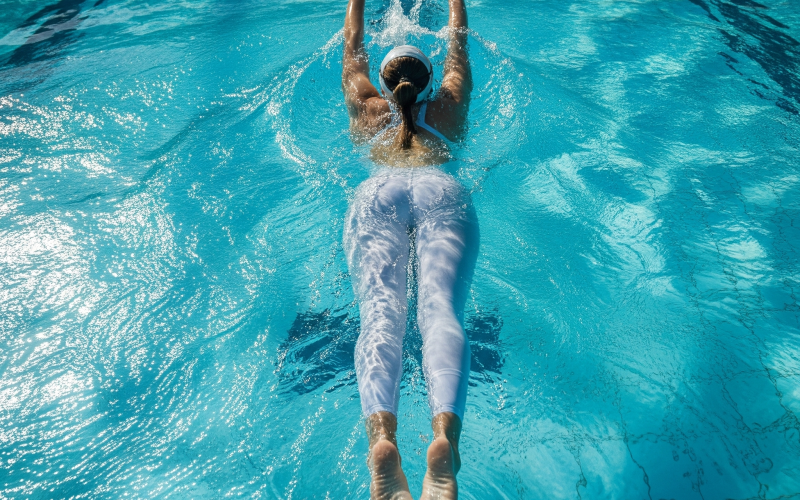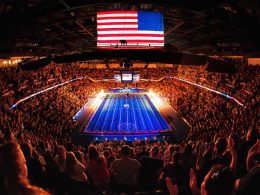Any level of swimmer can benefit from improving their backstroke, from experienced swimmers looking for speed to beginners learning the basics to coaches helping other swimmers get better. Backstroke is more than just swimming on your back; it’s a complicated stroke that demands careful timing, body alignment, and propulsion to go through the water quickly. To do a good backstroke, your core must be steady and your body must be in the right position. Your head should stay still as your body rotates smoothly along its axis. For more tips on swimming fitness, check out Swim Fit.
Arm and leg moves must be coordinated—your arms should work nonstop, with one arm pulling underwater and the other recovering above the water. A continuous flutter kick, on the other hand, increases propulsion, which helps you keep your balance and pace. Breathing and rhythm are both very crucial. Swimmers need to know how to breathe properly so they can keep going without losing their form. Keeping a constant rhythm makes it easier to swim and keeps strokes flowing, which makes it easier to go longer lengths without getting tired.
Swimmers can steadily improve their technique and efficiency by focussing on these things during purposeful practice. Drills that focus on body rotation, arm recovery, and controlled kicking can assist improve form, and a coach’s regular input can help you find areas where you need to work on. Swimmers can do better in training and competitions if they learn these basics. This will give them an edge in performance and confidence in their talents. For more tips and tools to enhance your swimming journey, check out the best swim gear.Understanding Backstroke Basics
1. Body Position
Keeping a streamlined position in the water makes it easier to move and speeds you up. To reduce drag, it’s important to have the right body alignment. Stay as close to the surface of the water as you can. Keep your core muscles tight to keep your hips from falling, which can slow you down. Imagine a straight line going from your head to your toes. Use that image to help you keep good posture while you swim.
2. Arm Movements
Controlled arm movements are what make propulsion work. Start each stroke by bringing one arm under the water in a wide yet controlled way as the other arm rises smoothly to the surface. Keep your elbow up throughout the pull phase to get the most force. Don’t splash the water while you’re recovering. A fluid and rhythmic action can be achieved by aiming for gentle fingertip entry instead. Think of your arms as a windmill that always works to move you ahead.
3. Head Position
Keep your head facing directly toward the ceiling or sky, avoiding unnecessary tilting that could disrupt your body alignment. Relax your facial muscles and practice steady breathing to maintain a calm rhythm. This minimizes tension and ensures consistency during extended backstroke sessions.
4. Body Rotation
Rotating the spine well, which is also called “hip roll,” makes each stroke stronger. As one arm pulls, let your torso turn a little bit. This will use your core muscles to build up speed. Getting your hips and shoulders to work together makes your posture better and helps you move forward. Don’t rotate too much, as this can make things less stable and slow you down. To be more efficient in the water, practise rolling smoothly and on purpose.
5. Breathing Techniques
One advantage of the backstroke is the ease of breathing since your face remains above water. Develop a consistent breathing pattern that aligns with your arm movements. Proper breathing techniques not only prolong endurance but also add enjoyment to swimming.
Avoiding Common Backstroke Mistakes
- Incorrect Body Position
When your hips are dropped in the water, drag increases. This makes swimming less efficient, which wastes energy. This is a typical mistake that can really slow you down. To rectify this, use your core muscles and try to stay flat and streamlined on the surface of the water. By lowering the resistance, you can glide more easily, which makes each move more powerful.
- Faulty Arm Recovery
Improper or slow arm recovery can disrupt your swimming rhythm and lead to early fatigue. This often happens when swimmers don’t fully extend their arms or let their movements become sloppy. Concentrate on smooth, precise arm motions during each stroke cycle to improve. A proper arm recovery not only conserves energy but also helps maintain a consistent and efficient stroke technique.
- Neglecting Backstroke Flags
Backstroke swimmers depend a lot on the backstroke flags to know where the pool is and how to get ready for turns or finishes. Not paying attention to these flags can make you misjudge distances and lose precious seconds in a race. Count how many strokes it takes to reach the wall after going under the flags during practice. This improves your muscle memory and gives you confidence and accuracy during events, which helps you avoid mistakes that cost a lot of money.
Building Strength and Speed in Backstroke
1. Endurance Training
- Streamline Flutter Kicks
Push off the wall, maintain a streamlined position, and execute flutter kicks to power your lower body while enhancing endurance.
- Include IM Sets
Swimming medley sets that incorporate backstroke build overall stamina and versatility.
2. Speed Drills
- Stroke Count Workouts
Monitor your stroke count per lap and aim to reduce it with refined technique and efficiency.
- Interval Training
Change between mild and high levels of effort. For example, swim 50 yards at faster and faster speeds while taking short breaks. This tests your endurance and teaches your body how to keep up its performance at faster speeds.
3. Strengthening Exercises
- Core Workouts
Glute bridges, Russian twists, and hollow holds target key muscles for improved posture and streamlining.
- Leg Strengthening
Flutter kicks and box jumps boost lower-body strength, essential for propulsion in backstroke.
- Upper-Body Strengthening
Perform pull-ups and shoulder presses to enhance the pulling force of your arms, increasing overall speed.
Utilizing Backstroke Flags for Better Navigation
Backstroke flags are very useful for swimmers who are approaching close to the wall of the pool. During practice, pay attention to how many strokes you take to find out exactly how many you need for a clean turn. With this knowledge, you can better time your moves, stop pausing, and get an edge in races.
Monitor Performance and Use Virtual Tools
1. Track Your Progress
After each training session, keep a log, noting your times, distances, and improvement areas. Celebrating milestones motivates continual effort and sets achievable goals.
2. Leverage Online Resources
Platforms like SwimSmooth offer virtual coaching, personalized training plans, and stroke analysis. These tools provide in-depth feedback and insights to help identify areas of enhancement.
Take Your Backstroke to the Next Level
To master the backstroke, you need to be dedicated, use the right technique, and commit to organised practice. Swimmers can feel more confident and perform better in the water by using these drills and methods. If you really want to speed up your progress, you might want to look into swim programs that are run by professionals and include fitness training and targeted drills to improve your skills. Begin changing your swimming right away!












